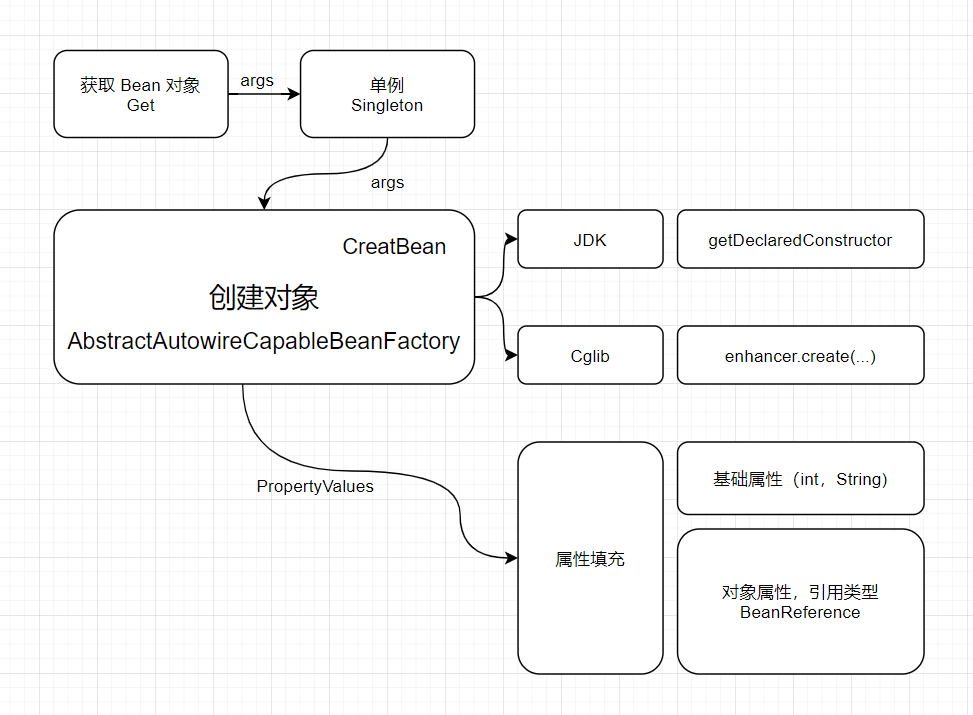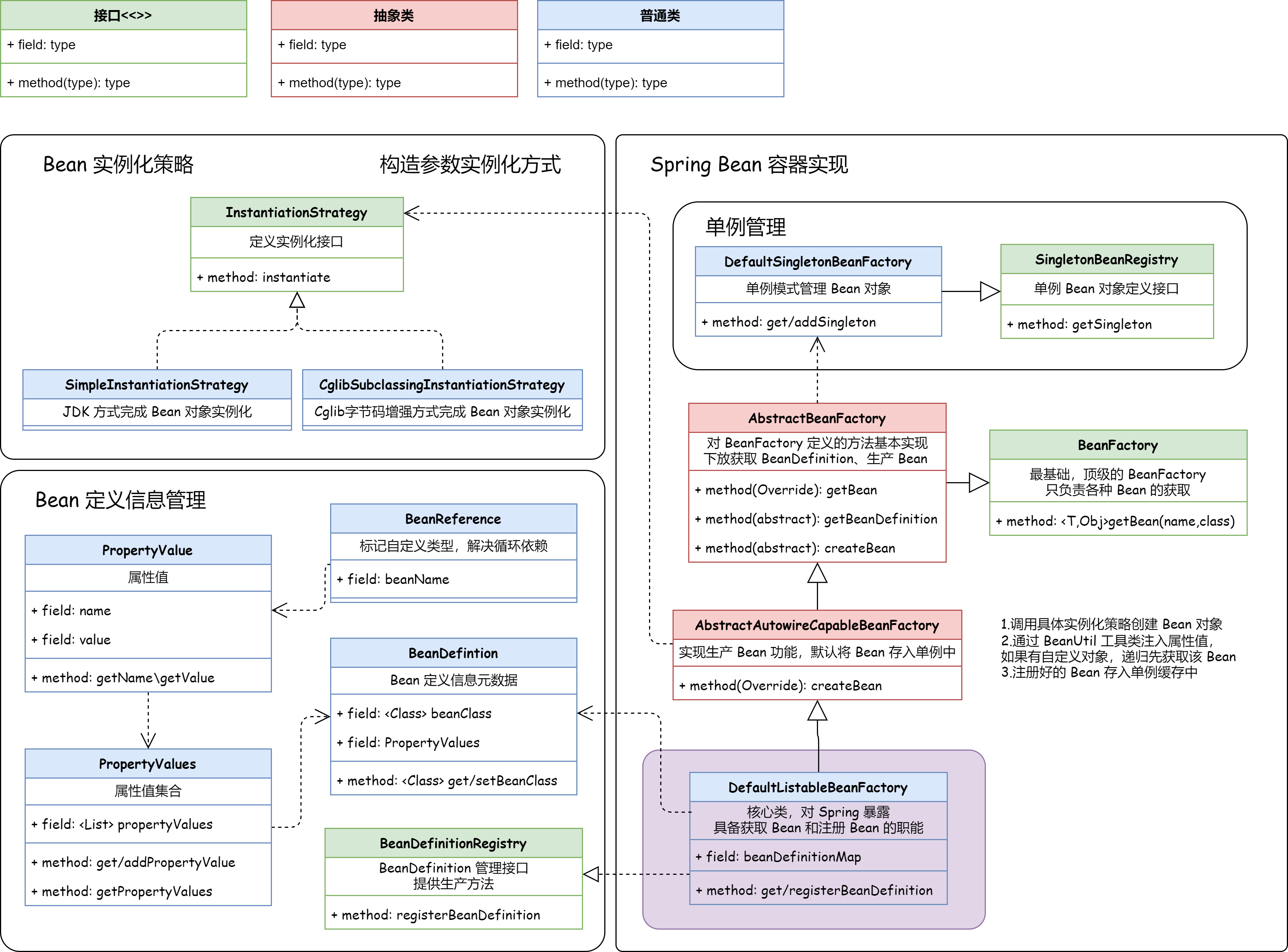【从零构建Spring|第四节】 Bean的属性注入
日志
前几节内容,我们初步实现了一个容器、定义 Bean、注册 Bean 、实例化,按照是否包含构造函数实现不同的实例化策略。
本章节有以下变动:
- 查询类中是否有属性,如果类中包含属性,在实例化时注入属性信息。对于属性的填充不只是 int、Long、String,还包括还没有实例化的对象属性,都需要在 Bean 创建时进行填充操作。不过这里我们暂时不会考虑 Bean 的循环依赖,否则会把整个功能实现撑大,这样新人学习时就把握不住了,待后续陆续先把核心功能实现后,再逐步完善
设计
架构图
鉴于属性填充是在 Bean 使用 newInstance 或者 Cglib 创建后,开始补全属性信息,那么就可以在类 AbstractAutowireCapableBeanFactory 的 createBean 方法中添加补全属性方法。

- 属性填充要在类实例化创建之后,也就是需要在
AbstractAutowireCapableBeanFactory 的 createBean 方法中添加 applyPropertyValues 操作。
- 由于我们需要在创建Bean时候填充属性操作,那么就需要在 bean 定义 BeanDefinition 类中,添加 PropertyValues 信息。
- 另外是填充属性信息还包括了 Bean 的对象类型,也就是需要再定义一个 BeanReference,里面其实就是一个简单的 Bean 名称,在具体的实例化操作时进行递归创建和填充,与 Spring 源码实现一样。Spring 源码中 BeanReference 是一个接口
Spring Bean 容器类关系

- 本章节中需要新增加3个类,
BeanReference(类引用)、PropertyValue(属性值)、PropertyValues(属性集合),分别用于类和其他类型属性填充操作。
- 另外改动的类主要是
AbstractAutowireCapableBeanFactory,在 createBean 中补全属性填充部分。
定义属性
在实例化时注入属性信息。对于属性的填充不只是 int、Long、String,还包括还没有实例化的对象属性,既然类型不能确定。那么干脆用一个 PropertyValue 统一就好了,强制将 Bean 的属性都统一使用 PropertyValue 替代。其有两个属性:name、value,其中 value 存储非基本类型时,使用 BeanRefence 引用(beanName)来替代。
实例化 Bean 时,先会查看 PropertyValue 是否有自定义类型,如果有先实例化该类型,后即可通过 beanName 从 Spring IoC 容器中获取 Bean,最后才继续实例化当前 Bean
public class PropertyValue {
private final String name;
private final Object value;
public PropertyValue(String name, Object value) {
this.name = name;
this.value = value;
}
}
|
public class PropertyValues {
private final List<PropertyValue> propertyValueList = new ArrayList<>();
public void addPropertyValue(PropertyValue pv) {
this.propertyValueList.add(pv);
}
public PropertyValue[] getPropertyValues() {
return this.propertyValueList.toArray(new PropertyValue[0]);
}
public PropertyValue getPropertyValue(String propertyName) {
for (PropertyValue pv : this.propertyValueList) {
if (pv.getName().equals(propertyName)) {
return pv;
}
}
return null;
}
}
|
- 这两个类的作用就是创建出一个用于传递类中属性信息的类,因为属性可能会有很多,所以还需要定义一个集合包装下。
public class BeanReference {
private final String beanName;
public BeanReference(String beanName) {
this.beanName = beanName;
}
public String getBeanName() {
return beanName;
}
}
|
Bean定义补全
public class BeanDefinition {
private Class beanClass;
private PropertyValues propertyValues;
public BeanDefinition(Class beanClass) {
this.beanClass = beanClass;
this.propertyValues = new PropertyValues();
}
public BeanDefinition(Class beanClass, PropertyValues propertyValues) {
this.beanClass = beanClass;
this.propertyValues = propertyValues != null ? propertyValues : new PropertyValues();
}
}
|
- 在 Bean 注册的过程中是需要传递 Bean 的信息,在几个前面章节的测试中都有所体现
new BeanDefinition(UserService.class, propertyValues);
- 所以为了把属性一定交给 Bean 定义,所以这里填充了 PropertyValues 属性,同时把两个构造函数做了一些简单的优化,避免后面 for 循环时还得判断属性填充是否为空。
Bean 属性填充
public abstract class AbstractAutowireCapableBeanFactory extends AbstractBeanFactory {
private InstantiationStrategy instantiationStrategy = new CglibSubclassingInstantiationStrategy();
@Override
protected Object createBean(String beanName, BeanDefinition beanDefinition, Object[] args) throws BeansException {
Object bean = null;
try {
bean = createBeanInstance(beanDefinition, beanName, args);
applyPropertyValues(beanName, bean, beanDefinition);
} catch (Exception e) {
throw new BeansException("Instantiation of bean failed", e);
}
addSingleton(beanName, bean);
return bean;
}
protected Object createBeanInstance(BeanDefinition beanDefinition, String beanName, Object[] args) {
Constructor constructorToUse = null;
Class<?> beanClass = beanDefinition.getBeanClass();
Constructor<?>[] declaredConstructors = beanClass.getDeclaredConstructors();
for (Constructor ctor : declaredConstructors) {
if (null != args && ctor.getParameterTypes().length == args.length) {
constructorToUse = ctor;
break;
}
}
return getInstantiationStrategy().instantiate(beanDefinition, beanName, constructorToUse, args);
}
protected void applyPropertyValues(String beanName, Object bean, BeanDefinition beanDefinition) {
try {
PropertyValues propertyValues = beanDefinition.getPropertyValues();
for (PropertyValue propertyValue : propertyValues.getPropertyValues()) {
String name = propertyValue.getName();
Object value = propertyValue.getValue();
if (value instanceof BeanReference) {
BeanReference beanReference = (BeanReference) value;
value = getBean(beanReference.getBeanName());
}
BeanUtil.setFieldValue(bean, name, value);
}
} catch (Exception e) {
throw new BeansException("Error setting property values:" + beanName);
}
}
public InstantiationStrategy getInstantiationStrategy() {
return instantiationStrategy;
}
public void setInstantiationStrategy(InstantiationStrategy instantiationStrategy) {
this.instantiationStrategy = instantiationStrategy;
}
}
|
- 这个类的内容稍微有点长,主要包括三个方法:createBean、createBeanInstance、applyPropertyValues,这里我们主要关注 createBean 的方法中调用的 applyPropertyValues 方法。
- 在 applyPropertyValues 中,通过获取
beanDefinition.getPropertyValues() 循环进行属性填充操作,如果遇到的是 BeanReference,那么就需要递归获取 Bean 实例,调用 getBean 方法。
- 当把依赖的 Bean 对象创建完成后,会递归回现在属性填充中。这里需要注意我们并没有去处理循环依赖的问题,这部分内容较大,后续补充。BeanUtil.setFieldValue(bean, name, value) 是 hutool-all 工具类中的方法,你也可以自己实现
Bean 生命周期:Bean 实例化 –> 属性注入
测试
public class UserDao {
private static Map<String, String> hashMap = new HashMap<>();
static {
hashMap.put("10001", "半糖");
hashMap.put("10002", "小鲨鱼");
hashMap.put("10003", "bantanger");
}
public String queryUserName(String uId) {
return hashMap.get(uId);
}
}
|
public class UserService {
private String uId;
private UserDao userDao;
public void queryUserInfo() {
System.out.println("查询用户信息:" + userDao.queryUserName(uId));
}
}
|
- Dao、Service,是我们平常开发经常使用的场景。在 UserService 中注入 UserDao,这样就能体现出Bean属性的依赖了。
测试用例
@Test
public void test_BeanFactory() {
DefaultListableBeanFactory beanFactory = new DefaultListableBeanFactory();
beanFactory.registerBeanDefinition("userDao", new BeanDefinition(UserDao.class));
PropertyValues propertyValues = new PropertyValues();
propertyValues.addPropertyValue(new PropertyValue("uId", "10001"));
propertyValues.addPropertyValue(new PropertyValue("userDao",new BeanReference("userDao")));
BeanDefinition beanDefinition = new BeanDefinition(UserService.class, propertyValues);
beanFactory.registerBeanDefinition("userService", beanDefinition);
UserService userService = (UserService) beanFactory.getBean("userService");
userService.queryUserInfo();
}
|
- 与直接获取 Bean 对象不同,这次我们还需要先把 userDao 注入到 Bean 容器中。
beanFactory.registerBeanDefinition("userDao", new BeanDefinition(UserDao.class));
- 接下来就是属性填充的操作了,一种是普通属性
new PropertyValue("uId", "10001"),另外一种是对象属性 new PropertyValue("userDao",new BeanReference("userDao"))
- 接下来的操作就简单了,只不过是正常获取 userService 对象,调用方法即可。
测试结果
查询用户信息:半糖
Process finished with exit code 0
|
- 从测试结果看我们的属性填充已经起作用了,因为只有属性填充后,才能调用到Dao方法,如:
userDao.queryUserName(uId)
总结
- 在本章节中我们把 AbstractAutowireCapableBeanFactory 类中的创建对象功能又做了扩充,依赖于是否有构造函数的实例化策略完成后,开始补充 Bean 属性信息。当遇到 Bean 属性为 Bean 对象时,需要递归处理。最后在属性填充时需要用到反射操作,也可以使用一些工具类处理。
- 本章也体现一种统一思想,Java 里面的 Object 类就是统一的类,所有的类的父对象都是 Object,在我们常用的 Mybatis 里面也有统一的IService 类,这个类是所有 Service 类的统一类。而这一步我们实现的类里面 PropertyValue 也算是一种统一,既是把所有 Bean 对象里面的成员对象统一包装成 PropertyValue,就不用管他原先到底是什么类型的对象了。


















